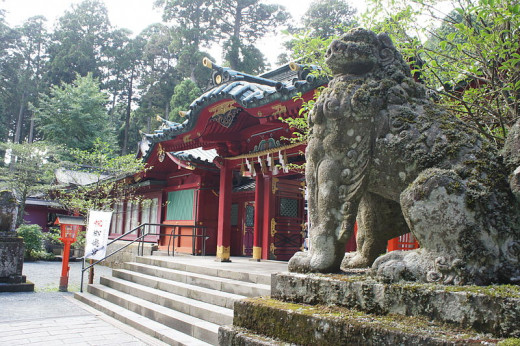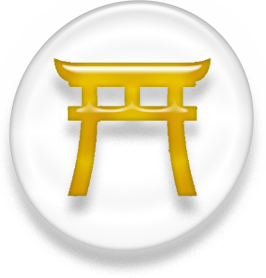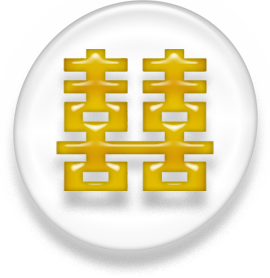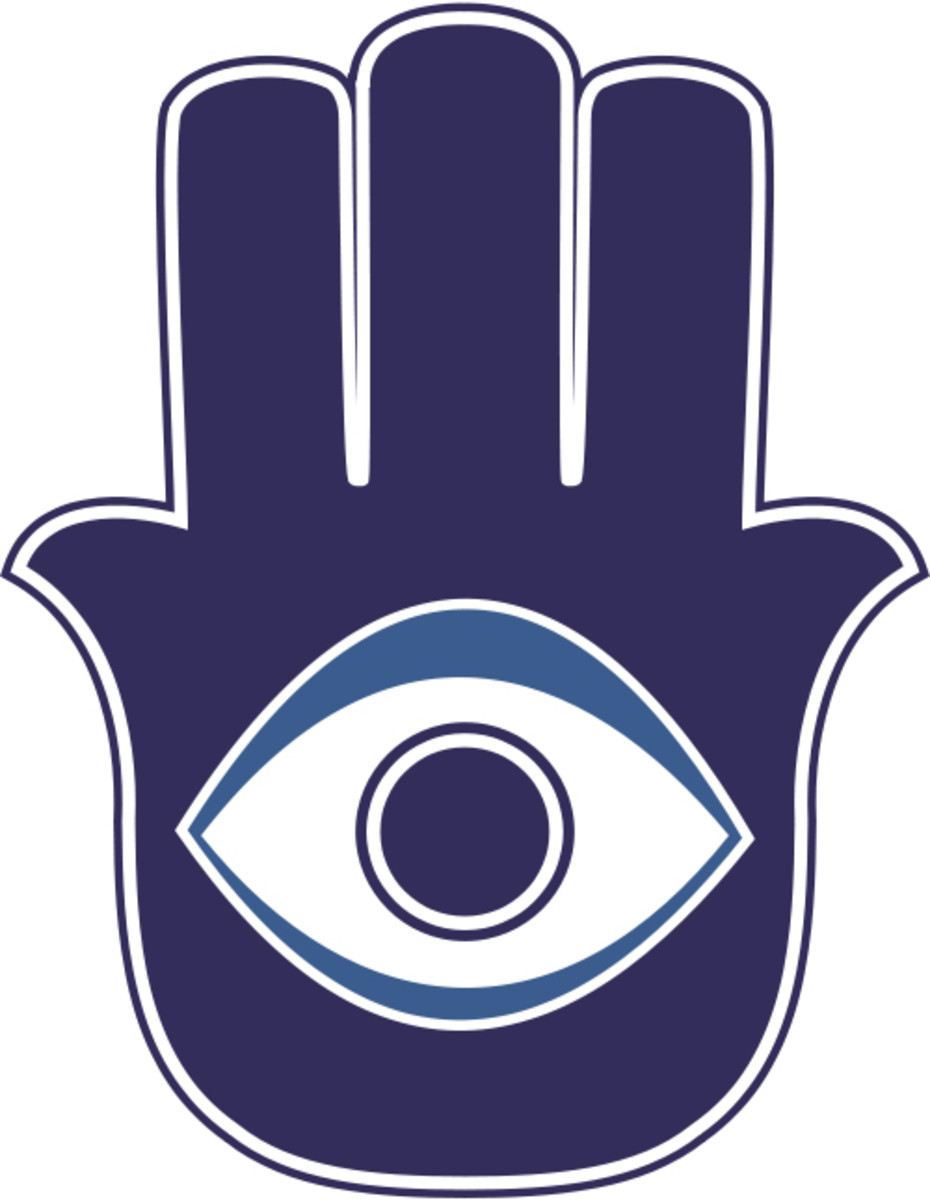What Takes More Courage Than Rebellion? Considering Another Point of View Part III: Far East Asian Religions
The preceding hub explored Hindu-based religions. To access it, please visit this link:
http://sayyestolife.hubpages.com/hub/Considering-Another-Point-of-View-Part-II-Hindu-Based-Religions

Here, we explore the folk religions of the Far East Asian countries of Japan and China. Many of you may consider these exotic, since they are rarely practiced outside their home countries. Perhaps you’re even wondering why I’m including them, since 8 of the 10 most practiced religions got their beginnings in this region:

I’m doing so because it is important to explore as many points of view as possible. Consider this fable from ancient India:
The Blind Men and the Elephant
Translated and written as a poem by John Godfrey Saxe (1816–1887)
It was six men of Indostan to learning much inclined,
Who went to see the Elephant (though all of them were blind),
That each by observation might satisfy his mind
The First approached the Elephant, and happening to fall
Against his broad and sturdy side, at once began to bawl:
“God bless me! but the Elephant is very like a wall!”
The Second, feeling of the tusk, cried, “Ho! What have we here
So very round and smooth and sharp? To me ’tis mighty clear
This wonder of an Elephant is very like a spear!”
The Third approached the animal, and happening to take
The squirming trunk within his hands, thus boldly up and spake:
“I see,” quoth he, “the Elephant is very like a snake!
The Fourth reached out an eager hand, and felt about the knee.
“What most this wondrous beast is like is mighty plain,” quoth he;
” ‘Tis clear enough the Elephant is very like a tree!”
The Fifth, who chanced to touch the ear, said: “E’en the blindest man
Can tell what this resembles most; deny the fact who can
This marvel of an Elephant is very like a fan!”
The Sixth no sooner had begun about the beast to grope,
Than, seizing on the swinging tail that fell within his scope,
“I see,” quoth he, “the Elephant is very like a rope!”
And so these men of Indostan disputed loud and long,
Each in his own opinion exceeding stiff and strong,
Though each was partly in the right, and all were in the wrong!
Moral
So oft in theologic wars, the disputants, I ween,
Rail on in utter ignorance of what each other mean,
And prate about an Elephant not one of them has seen!
(Copied from: http://www.wordfocus.com/word-act-blindmen.html )
Ultimately, NO ONE can be absolutely certain what lies beyond this Earthly realm. Each culture has some semblance of an idea, but one is no more or less accurate than any other. We might as well learn from each other, and fit the pieces together as best we can.

Shinto
Basic Philosophy: Shinto is the folk religion of Japan, the country which produces the world’s best engineers. Shintoists believe a sacred spirit, called kami, resides in all things, living and non-living. They believe human nature is basically positive, but because people defile themselves through certain behaviors or exposure to particular situations, they must do acts of purification. These are done at sites that have a unique amount of kami, and therefore contain a special spiritual presence. Often, they are features of nature – mountains, unusual rock formations, unique trees, waterfalls, or rivers. If no such site is readily available, a shrine will be built as an area for worship and purification rites. Shintoists also have a kamidana, or home shrine, where they worship daily. Shinto is based on four relationship affirmations: to Matsuri (the worship of the Kami gods and spirits of ancestors), to family and tradition, to sacred nature, and to physical cleanliness.
Shinto is practiced by 80% of Japan’s population. Most of them practice another religion, such as Buddhism or Confucianism, in combination. Shintoists believe in peaceful co-existence of all people, honoring the kami in them. They believe the gods work together to protect mankind, who are children of the gods. They respect individuality, but strongly emphasize the importance of community and each person’s role in it. They believe in living life to the fullest, making each moment count. Their ethical focus is on sincerity, honesty, and purity.
Type
| Polytheist
|
Holy Book(s)
| Officially, there are none. However, the Kojii, which is a record of ancient matters, and the Nihongi, the Chronicles of Japan, tell the country’s history, literature, mythology, oral traditions and topography, and ancient Shinto ceremonies.
|
House of Worship, Day of Worship, Typical Worship Service / Rituals and Celebrations
| Their house of worship is called a shrine, and their clergy are referred to as priests. It is believed a shrine is the home of the gods. The inner sanctuary, where only the Chief Priest can enter, contains a special symbol, usually a mirror or sword. Most Shintoists visit a shrine twice a month; on the 1st, and on the 15th. They perform the purification rites of washing themselves, give a small offering, pray, and bow to the Kami. They also visit on holidays, or for a rite of passage such as a birth, or erection and dedication of a new building.
|
Most Japanese homes contain two altars; one for Shinto, the other for Buddhism, and they typically worship at both every day. They light candles and leave food offerings to the Kami.
| |
Being a Shintoist does not require public profession. A newborn baby is automatically enrolled in the nearest shrine, and when the family moves, their names are also listed at the new location. This is done not as an act of imposing beliefs, but rather is seen as the local kami welcoming the newborn into this world, and the next one after they die. It also does not matter if the child changes religions later if life. Likewise anyone, regardless of their religious beliefs, can visit a shrine.
| |
Important holidays are Haru Matsuri (Spring Festival), Aki Matsuri or Niiname-sai (Autumn or Harvest Festival), and Rei-sai (Annual Festival, held in June), during which miniature shrines are carried through the parish on shoulders of the priests.
| |
Estimated Year Founded
| 660 BCE
|
Founder / Central Figure(s)
| Shinto has no official founder. Amenominakanushi is the first Kami, with both male and female characteristics. Other principal Kami are Amaterasu, the Sun Goddess; Tsuki-yomi, the Moon God; Susano-o, the Storm God, and Leech-child. These Gods, along with family ancestors, are figures of worship. It is believed they protect followers and maintain their happiness.
|
Country of Origin
| Japan
|
Countries Where Practiced
| Mostly in Japan, practiced by 80% of the population. It is often combined with Buddhism and Confucianism.
|
Percentage / Numbers of World Population Practicing It
| 4 million (<0.1%). It is the world’s 10th most practiced religion.
|
Number of Denominations
| There are six. SHRINE SHINTO is the oldest, and the main one; IMPERIAL is practiced exclusively by the royal family on the palace grounds; FOLK involves spirit possession, divination, and shamanic healing, with some rites coming from other religions such as Buddhism, Confucianism, or Taoism; SECT, which developed in the 1890s, is a more modern form of SHRINE, having their own scriptures; KOSHINO (literal meaning, “Old Shinto”) is a resurrection of the religion before Buddhism entered Japan; and FACTION, which developed after World War II; it is a collection of new religions.
|
Story
| Shinto originally began as a folk religion that involved shamanism and agricultural rites. First Confucianism, then Buddhism, entered Japan in the 5th century CE. Many Shinto ethics were garnered through Confucianism; in fact, the name Shinto is originally Chinese, meaning “Way of the Gods” since Shintoists worship spirits as gods. As Shinto combined with Confucianism and Buddhism, various denominations developed.
|
Shinto was the official religion of Japan until after the country was defeated in World War II. The Emperor was seen as an important Kami; losing the war meant he did not have the power to positively affect fate, so the government stopped funding shrines. However, Shinto is widely practiced throughout Japan to this day.
| |
How the World Began
| Amenominakanushi is the first Kami, with both male and female characteristics. Other principal Kami are Amaterasu, the Sun Goddess; Tsuki-yomi, the Moon God; Susano-o, the Storm God, and Leech-child. Together they created the Universe, and all in it.
|
Additional Kami were born, and the archipelago of Japan was eventually created by Izanagi ("He-who-invites") and Izanami ("She-who-is-invited"). They stirred the ocean with a spear, and islands were created from drippings when the spear was removed.
| |
What Happens After We Die
| After death the person becomes a spirit, or "family kami". According to Shinto, they enter a gloomy realm, similar to Hades in Greek mythology. Corpses are also seen as a pollution source. Because Shinto sees death in such a negative light, funerals are usually held with Buddhist traditions; the concept of reincarnation is more comforting to the bereaved.
|
How the World will End
| Though the Universe had a beginning, there is no end. It will continue to expand beyond eternity. In order for the world to improve, it is important to revere life and live it to the fullest.
|
Positive Aspects
| Shinto is extremely liberal. It allows people to be as devoted or casual as they want to be, in practicing it. It also accepts other religions, as is evidenced by the blending of Confucianism and Buddhism in its practice. Recently, it has accepted Christian practices as well. As a result, even though Japan is becoming more secularized, few people are bitter against the religion.
|
Negative Aspects
| Since Shintoism is virtually exclusive to Japan, it is difficult to truly study it outside the country. It can be cumbersome attempting to practice it elsewhere in the world, especially for Japanese residents who move to other countries, since it can be virtually impossible to locate a natural kami site outside Japan. Even within Japan, studies of Shinto are limited; this, combined with the influx of other religions, could cause it to die out.
|
Modern Day Issues
| Since World War II, Japan has established separation of religion and politics. Urbanization of the country has also changed the nature of Shinto rites, making them more like civic pageants. Many sects have emerged from the two newest denominations, Sect and Faction. The fact that shrines are no longer getting government support is threatening the religion; debates are being held whether or not to contest this to preserve it, and what to do about modern day changes.
|
Famous Shintoists
| Hantaro Nagaoka, physicist who discovered the basic atom model contains a central nucleus; Aikitu Tanakadate, physicist who virtually invented Japanese-style roman letters; Naozo Ichinohe, astronomer and founder of the magazine, “Contemporary Science”; Kenichi Mori, developer of the first successful word processor in the Japanese language; Rikou Majima, chemist who has studied the ingredients that make up Japanese lacquer.
|

Confucianism
Basic Philosophy: Confucianism is the folk religion of China, which for most of human history has enjoyed one of the highest standards of living in the world. Many of the products we take for granted today – paper, ink, porcelain, silk – were invented in China.
Confucianism is a humanistic religion, meaning it sees the secular as sacred, and it is up to mankind to maintain morality and solve its problems. Humans are teachable, and able to transcend their imperfect natures. The religion helps towards that end with laws based on moral ethics. Ren is an obligation of altruism and humaneness for other individuals. Yi is the upholding of righteousness and the moral disposition to do good. Li is a system of ritual norms and propriety that determines how a person should properly act in everyday life. Zhi is the ability to see what is right and fair, or the converse, in the behaviors exhibited by others. Confucianism holds one in contempt, either passively or actively, for the failure of upholding the cardinal moral values of Ren and Yi. Rather than worshipping a deity, Confucianism promotes honoring one's ancestors and family. People should obey their superiors, but superiors must be ethical, or they will be ousted.
The ideal person is a Junzi; the opposite is a Renzi. There are Six Relationships: ruler to ruled, father to son, teacher to student, elder brother to younger brother, husband to wife, and friend to friend. Everyone must know their place and call each place by its true name to keep order. You must rule yourself before you can rule others. Anyone can become a Junzi, but it is difficult, taking years of study and training.
Type
| Atheist. It may sound strange for a religion to be atheist, but all it means is that Confucianists do not believe in a Supreme Deity. They worship their ancestors, who are understood to exist in another realm and have some continuing influence in this world. Worship ensures their ancestors’ benefit in the next life, and favorable influence in this one.
|
Holy Book(s)
| Five Classics: Shu Ching (history), Shih Ching (odes) I Ching (changes), Ch'un Ching (spring and autumn annals) and Li Ching (rites). Many believe they were written by Confucius himself.
|
Four Books (introduction to Confucianism): Lun Yu, Ching Yung, Ta Hsueh, and Menf Tsu. These contain the saying of Confucius.
| |
House of Worship, Day of Worship, Typical Worship Service / Rituals and Celebrations
| Their house of worship is called a Temple. People go to temple mainly to worship Confucius, though Confucius himself would have protested that, believing himself to be merely a messenger rather than a God.
|
There are no specific days of worship, or holidays. Anytime, someone can perform certain rites honoring their ancestors, such as leaving a food offering on their graves. Confucianism is more a philosophy than a religion; its greatest emphasis is living a good honorable life on a daily basis.
| |
Estimated Year Founded
| 520 BCE
|
Founder / Central Figure(s)
| Confucius
|
Country of Origin
| China
|
Countries Where Practiced
| Historically, cultures and countries strongly influenced by Confucianism include mainland China, Taiwan, Hong Kong, Macau, Korea, Japan, and Vietnam, as well as various territories settled predominantly by Chinese people, such as Singapore.
|
Percentage / Numbers of World Population Practicing It
| 6.3 million (0.1%). It is the 8th most practiced religion in the world.
|
Number of Denominations
| There are 8, all developed after its founder’s death. They are Mencius, Xunzi, Dong Zhongshu, Song Confucianism, Ming Confucianism, Korean Confucianism, Qing Confucianism, and Modern Confucianism.
|
Story
| Confucius was born in 551BCE, in what is now Shantung Province of China. He is of the class of Shi, which is between royalty and the common people. His father died when he was 3 years old, so he grew up poor. His mother was his first teacher; from her, he acquired a love of learning. It is unknown who his other teachers were, but he gained considerable knowledge of the six important subjects of that place and time – arithmetic, music, ritual, calligraphy, archery, and chariot-riding. In his 30s, he himself became a teacher.
|
While teaching, he developed his own ideas regarding society, education, and government. He accumulated many devout followers among his students. In 501 BCE, he was appointed his first political position, as a town governor. He rose through the political ranks, and began attracting opponents and engaging in numerous conflicts and wars. Eventually he was exiled. He spent those years journeying throughout northeast and central China, promoting his belief system. At age 68, he eventually returned to his hometown of Lu, and spent the rest of his life teaching 77 disciples and writing the Five Classics. He sums up his life this way:
| |
“At 15 I set my heart on learning; at 30 I firmly took my stand; at 40 I had no delusions; at 50 I knew the Mandate of Heaven; at 60 my ear was attuned; at 70 I followed my heart's desire without overstepping the boundaries of right.”
| |
Confucius does not see himself as the founder of a religion, but simply a messenger who added new wisdom and knowledge to the folk religion already practiced. He did not live to see this knowledge utilized on a large scale, but now it is prominent not only in China, but many other countries throughout Asia.
| |
How the World Began
| Confucianism, as a rule, does not concern itself with how the world began. Some who practice Taoism or Daoism in conjunction believe the world was created by an all-powerful Deity, but He is unknowable, and people are better off not trying to get to know Him.
|
What Happens After We Die
| People are strongly encouraged to live a good life while here on Earth. Confucianism does not believe in an afterlife, where people will be rewarded or punished according to their deeds; that happens while they’re here on Earth. Peer pressure is what gives them the incentive to live moral lives.
|
How the World Will End
| Confucianism does not address how the world will end. Most Eastern religions believe life is a circle, a never-ending cycle of rebirth.
|
Positive Aspects
| Confucianism places great emphasis on personal responsibility, so people who practice it avoid blaming others for their behavior. This makes them more likely to make wise choices for themselves, and to lead positive lives.
|
Confucius produced the idea of leadership through virtue and merit, rather than by bloodline. This idea spread through Europe in the 17th century, and has since been promoted throughout the world.
| |
Negative Aspects
| Filial Piety can lead people down the wrong path. Communists blame Confucianism for the state China was in at the end of WWII. The belief that widows should not remarry has led to the feminization of poverty (this belief has since been revamped). Its legalistic nature does not always take into account people’s individual issues.
|
Modern Day Issues
| Over the past century, practice in Confucianism has ebbed. However, it is beginning to rise again. It has been credited to the current economic resurgence of China, and Viet Nam.
|
Japan has long practiced Confucianism along with its own folk religion, Shinto. In fact, Shinto gained its code of ethics from Confucianism. Both have ancestor worship in common, so it is an easy blend.
| |
Famous Conficianists
| Lu Han, Singer; Yip Man, martial arts instructor; Tu Wei-Ming, professor at Harvard University; Mencius, one of Confucius’ original disciples and founder of that particular denomination; Oshio Heihachiro, Samurai officer and neo-Confucianism scholar; Song Si-yeol, author and humanitarian.
|
To read the next and final hub in this series, Combined Religions, please visit this link:
http://sayyestolife.hubpages.com/hub/Considering-Another-Point-of-View-Part-IV-Combined-Religions

http://shintoreligion.wikispaces.com/Shinto-Origins
http://en.wikipedia.org/wiki/Shinto
http://www.religionfacts.com/shinto/index.htm
http://school.phippy.com/shinto/state.html
http://www.kt.rim.or.jp/~n-inoue/pub-eng.files/pd05-coe.htm
http://eos.kokugakuin.ac.jp/modules/xwords/entry.php?entryID=738
© 2014 Yoleen Lucas





